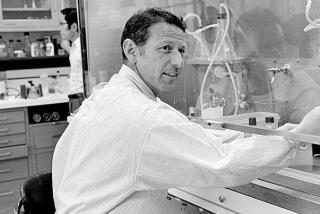An Engineer’s Engineer : Peer Calls Medical Inventor ‘Real Genius, the Leading Edge’
- Share via
LAGUNA HILLS — Terry M. Haber describes himself simply as an artist and poet. But his peers say he is among America’s most prolific medical inventors, one whose groundbreaking devices could save hundreds of health care workers from deadly blood-borne diseases including AIDS and hepatitis B.
For Haber’s work, 170,000 design engineers selected him “Engineer of the Year” from a field of top scientists, including NASA’s chief, Adm. Richard H. Truly; Ben Rich, the Lockheed president who spearheaded the design of the Stealth fighter, and Robert P. Popovich, the University of Texas professor who co-developed the closest thing yet to a portable artificial kidney.
Haber will receive the award, presented annually by Design News magazine, at a black-tie dinner in Chicago tonight.
Experts from around the nation describe the publicity-shy Haber as a master inventor in a class by himself, whose goal is to ease human suffering.
“He’s a real genius, the leading edge, the best I know,” said Dr. Murray L. Cohen, chief of medical device evaluations at the Centers for Disease Control in Atlanta. “He has a genuine compassion for people and he’s doing the right thing for the right reasons.”
Haber’s inventions range from hydraulic jogging shoes to a smoke mask that protects airline passengers after an accident. Applications for 29 patents are pending. Add to that 87 accepted patents that look like a wallpaper design plastered on the walls of his Laguna Hills laboratory.
Haber, however, has won the most raves for designing new devices that prevent accidental needle sticks among health care workers.
Needle sticks account for a fifth of the estimated 12,000 health care workers who become infected every year with deadly Hepatitis B, Cohen said. He estimated that 200 to 300 die of the disease.
Janine Jagger, an associate professor of neurosurgery at the University of Virginia, predicted that needle sticks also will infect about 100 workers this year with AIDS. So far, about 24 health-care workers have died from the virus through needle sticks.
Haber, an intensely private and modest person who declines to give his age, describes himself as a “curious person who followed the ideals of one’s family.” The curiosity he attributes to his father, a self-educated sign painter and former boxing champion who taught him a wide range of subjects, including astronomy, electricity and boxing.
But Haber also bears the scars of life in a gritty Brooklyn neighborhood--three broken ribs, three dislocated fingers and a bullet hole in the back.
“It was really a jungle,” he said.
His ticket out of Brooklyn was a scholarship to the Art Center College of Design in Pasadena. After graduating, Haber, who had looked on helplessly as a 12-year-old when his father died of a heart attack, began working on artificial heart valves and other medical equipment.
In 1981, Haber teamed up with mechanical engineer William Smedley to form Habley Medical Technology. There was a common bond--relatives who had colostomies and were forced to wear a bag outside their bodies to collect waste.
The engineers dedicated themselves to designing an artificial sphincter that would eliminate the need for external bags.
During this research, Haber discovered that health care workers who were trying to “cure sicknesses” would become infected by accidently sticking themselves with needles.
“He saw the problem and just plunged into it,” said Jagger, whose article in the New England Journal of Medicine stated that 90% of needle sticks were caused by faulty equipment. “Inventing comes to him as naturally as breathing.”
An example is a low-cost syringe that some European countries plan to distribute free to drug users to prevent AIDS among addicts who share contaminated needles. After use, the syringe self-destructs by automatically retracting its needle and breaking the fluid circuit.





